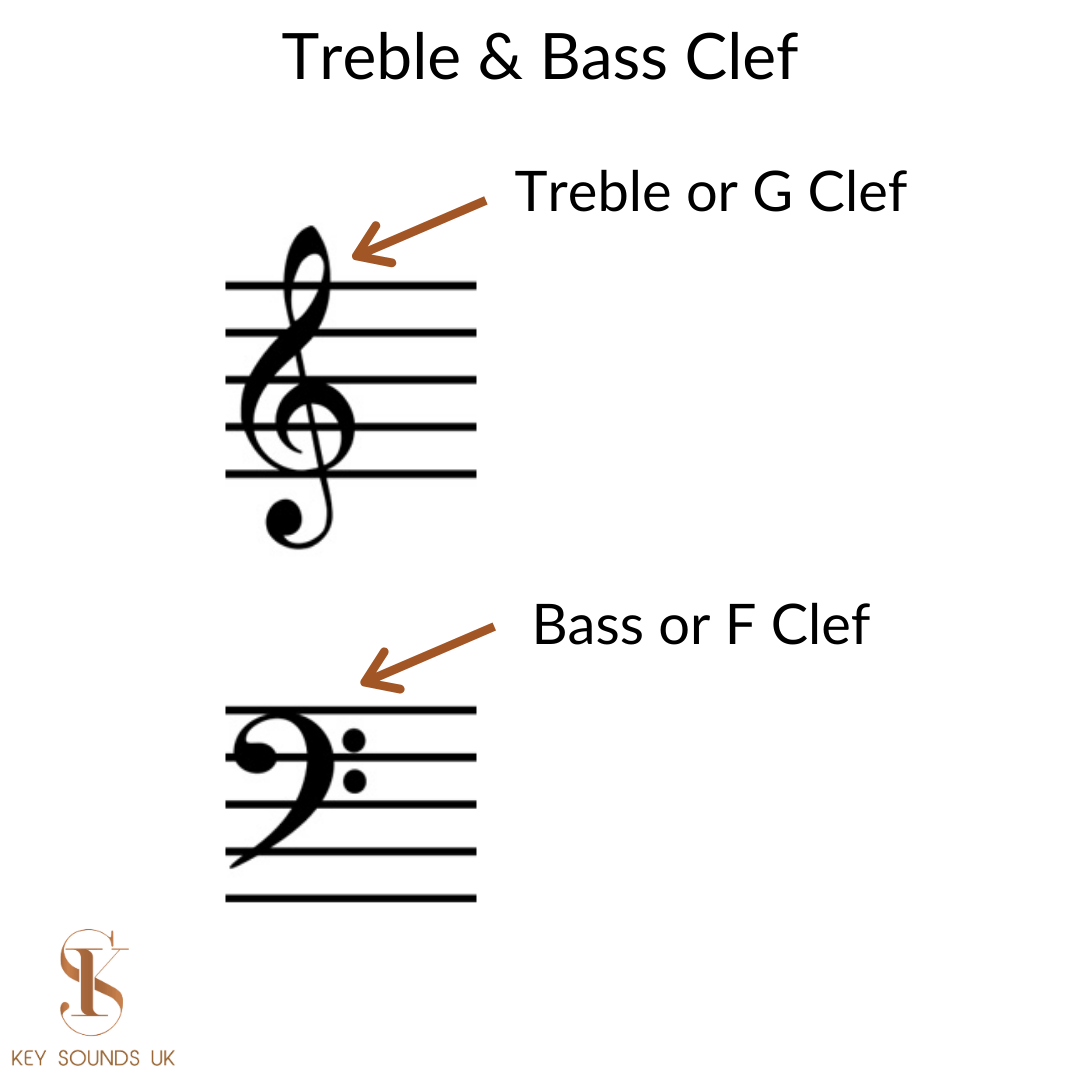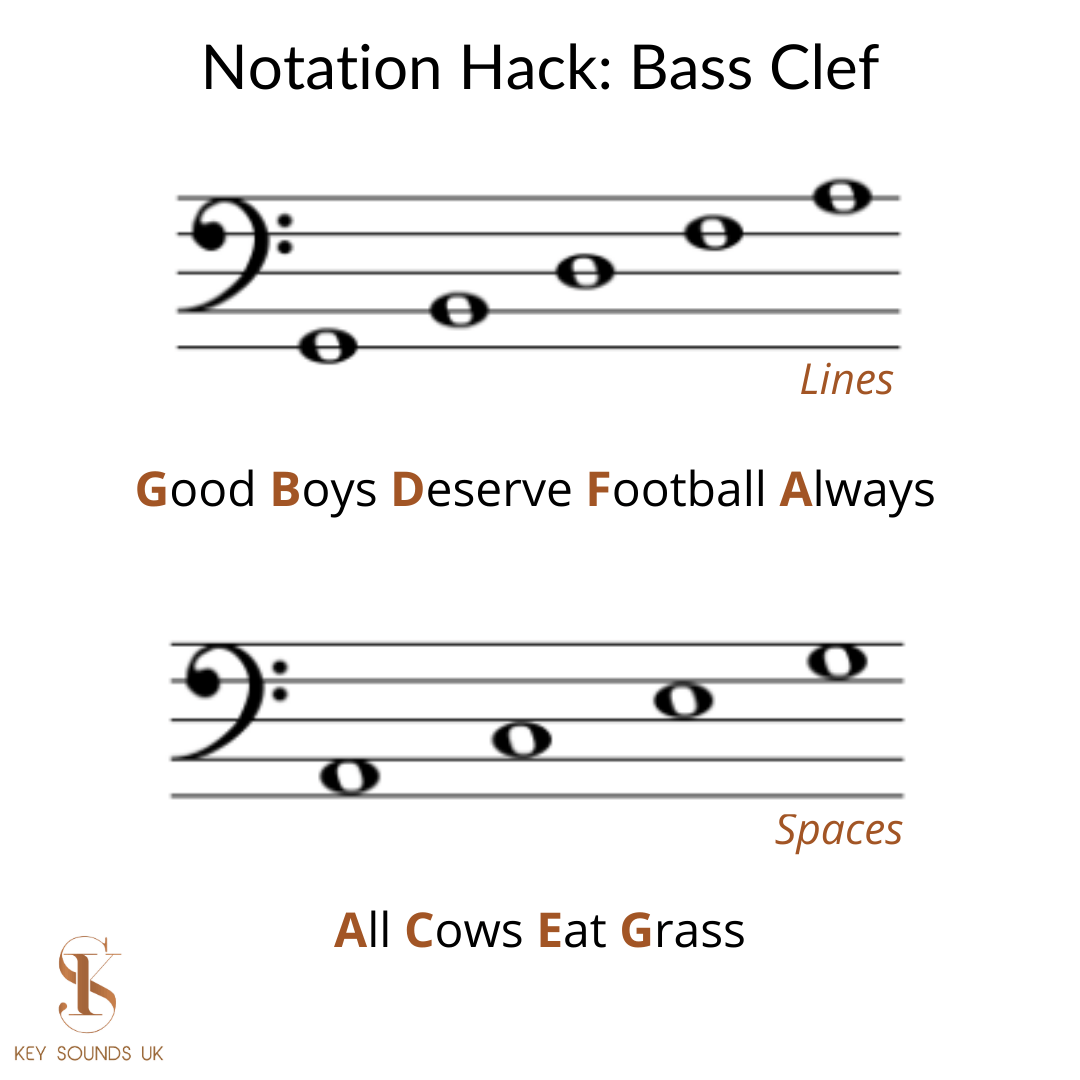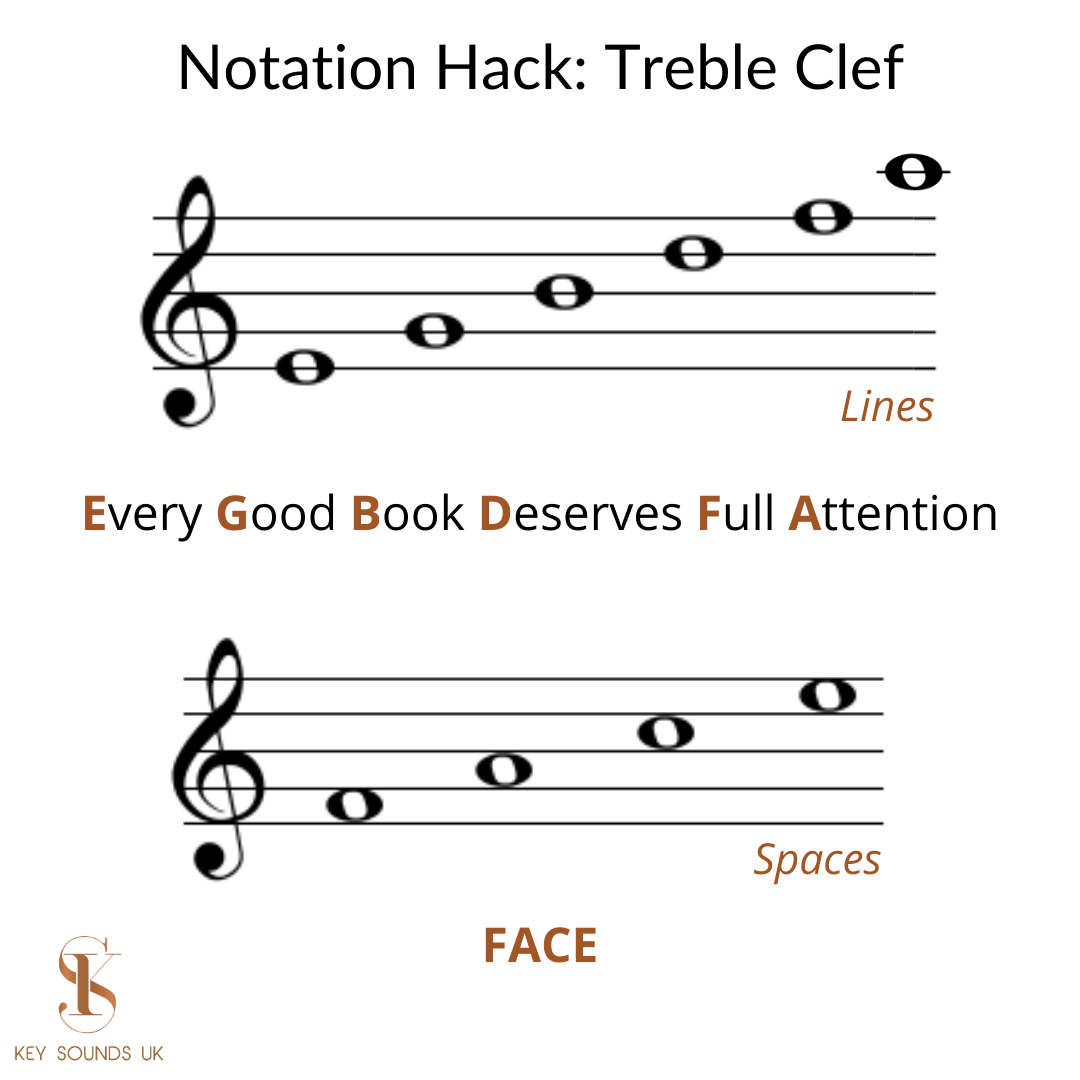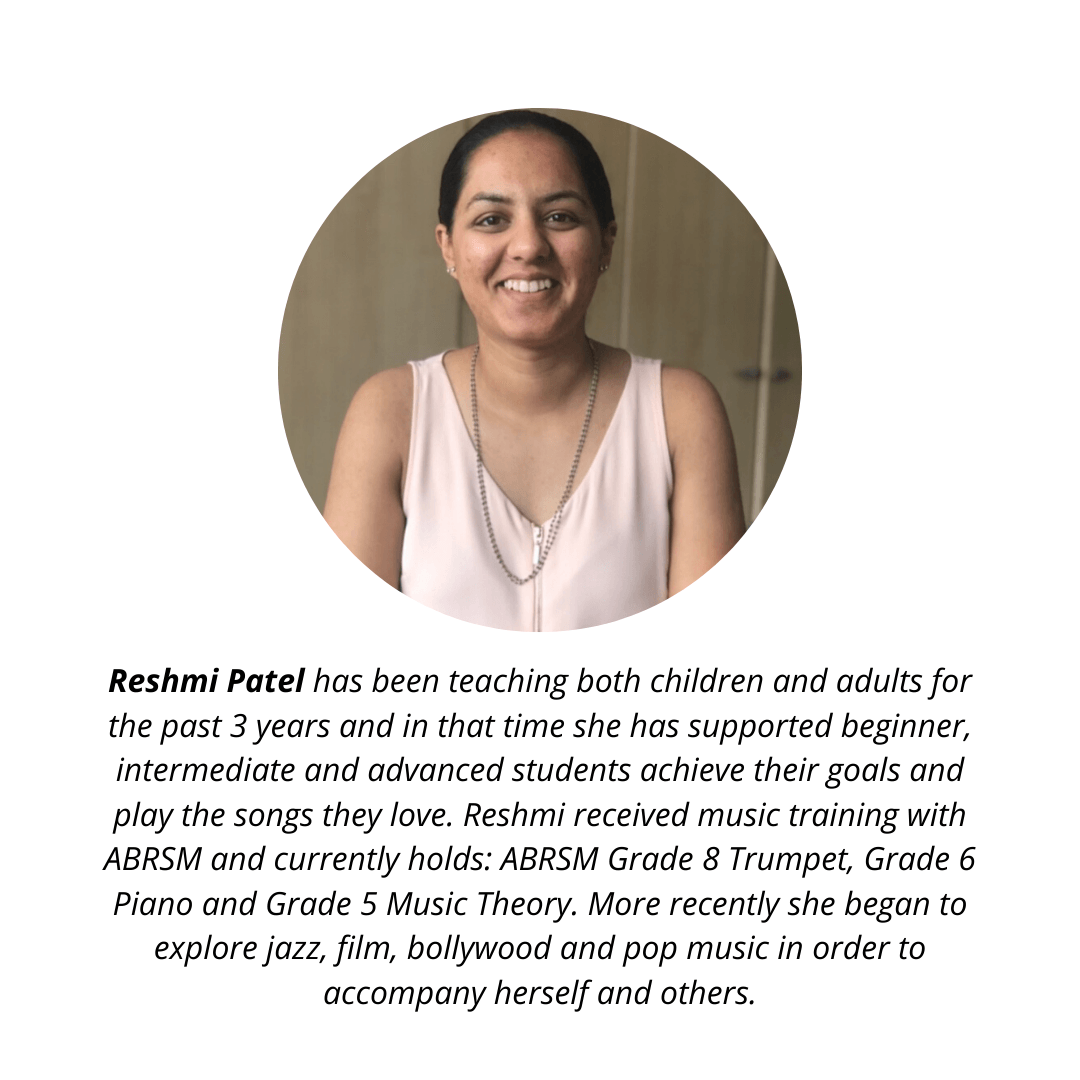Reshmi Patel • July 16, 2020
How to Read Sheet Music Faster
One of the greatest gifts a music student can receive is the gift of independence. To be able to pick up a song of their choice and having the skills to learn and play this at their own pace opens up a lifetime of both enjoyment and expression. In this blog post we’ll provide you with practical tips to ultimately help you read sheet music faster.
1. Stickers for your keys
Image: Amazon, Yuccer Piano Stickers
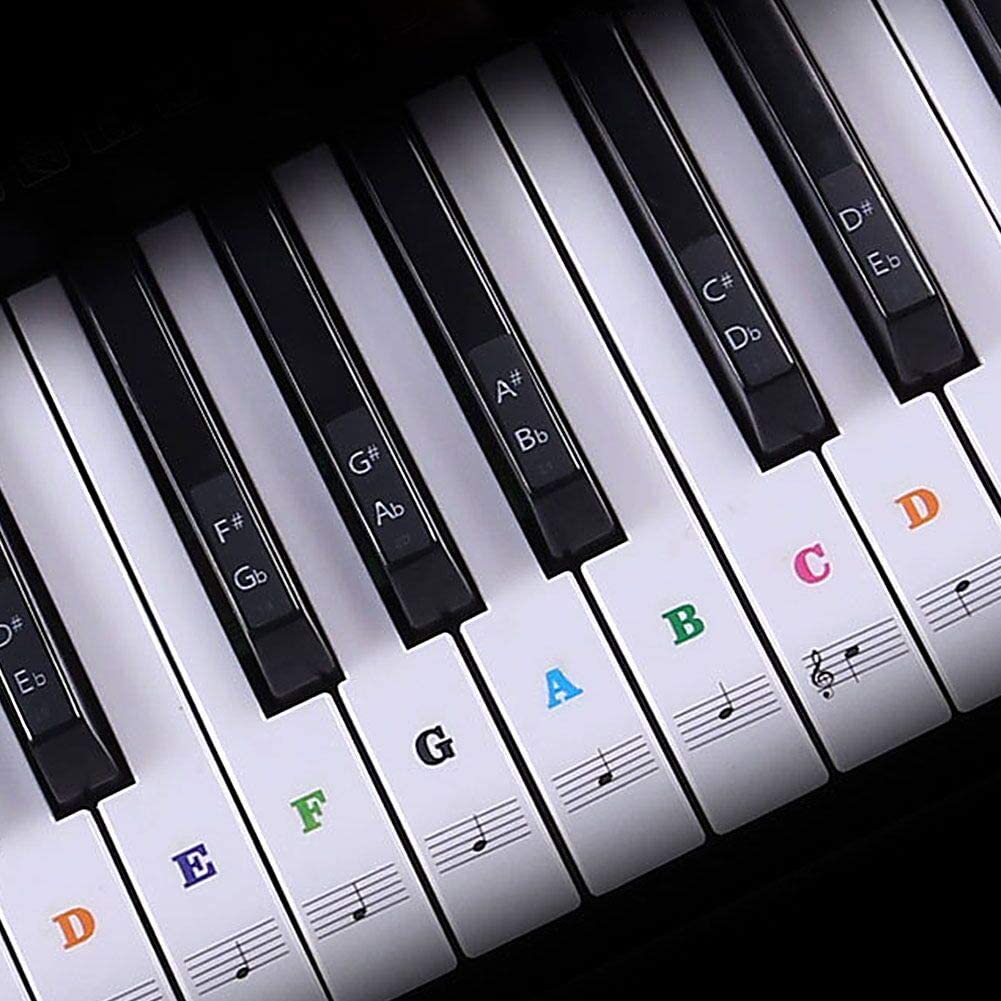
Although we don’t recommend this to everyone, for beginners who are really struggling to understand their keyboard geography*, we recommend they purchase piano stickers which can be stuck onto the individual keys. This will allow students to cross check reading their hand position with the music at a faster pace.
*Keyboard geography is how efficiently we can navigate the layout of the piano keys with the sheet music.
2. Treble Clef and Bass Clef
The Treble Clef can also be called the ‘G Clef’. This is because the first curve at the bottom crosses the letter G line which is found on the second line up on the stave.
Similarly, the Bass Clef can also be called the ‘F Clef’. This is because the large dot on the left-hand side of the clef where we would begin to draw the clef is on the second line down on the stave which is where we would find letter F on the music.
We can therefore use both of the alternative names of these clefs to work out notes on our music that are closer to them, as supposed to working them out from Middle C, which would take a longer period of time.
3. Treble/Bass Clef Acronyms
In music, there are several acronyms which can help us remember the pattern of the notes within the spaces and lines on the music.
For example, in between the Treble Clef spaces we can spell the word: ‘face’. In between the Treble Clef lines, we have the acronym: ‘Every Good Boy Deserves Football.’
In between the Bass Clef spaces we have an acronym which reads: ‘All Cows Eat Grass.’ In between the Bass Clef lines we have another acronym which reads: ‘Good Books Deserve Full Attention’.
4. Ledger Lines
Ledger lines are notes which are written below or above the stave.
Sometimes reading ledger lines can feel quite daunting but it’s important to bare in mind that the same patterns and rules apply when travelling from a line to a space on the music.
If we remember from section three of this article, the Treble Clef spaces spell the word ‘face’. We can also re-spell the word ‘face’ if we begin from the top line of the stave and ascend upwards on the music.
For most of us, we don’t tend to read ledger lines as frequently as the notes within or not too far out from the stave, so we may struggle to read ledger lines as fluently. However, using this hack will help you become more familiar with notes with the ledger lines faster!
5. Memorise Key Signatures
Finally, in order to read more complex music faster, you’ll need to learn and understand key signatures.
Key signatures tell us which flats and sharps we have in a scale, exercise or piece of music, rather than writing out the individual sharps or flats next to the notes.**
In the illustrations above you’ll find acronyms which will help you learn and memorise the order of the flats and sharps within key signatures and how they appear within the music.
**Writing a sharp, flat or natural sign directly next to a note in a scale, exercise or piece is known as an ‘accidental.’
Remember that when you are trying out these hacks to look at them little and often but also be patient with yourself. If you wish to know more about these hacks and resources, feel free to take a look around our website or connect with us directly.

It’s a familiar situation for many parents: your child loves their piano lessons. They come out smiling, talk excitedly about new songs, and sometimes even play little tunes at home just for fun. But when it comes to actual practice time…things suddenly feel a lot harder. Maybe they avoid it. Maybe they forget. Maybe they do a few minutes and wander off. And you start wondering: “Do they really enjoy this?” “Are we wasting time or money?” “Shouldn’t they be practising more if they like it?” Take a deep breath - this phase is incredibly common. Children can genuinely enjoy learning piano and still struggle to practise regularly. They’re often not being lazy. They’re simply figuring out how to build a new habit in the midst of a busy, ever-changing routine. Here’s how you can gently support them through this stage while keeping piano enjoyable and meaningful. 1. Notice the Signs of Enjoyment That Happen Outside Practice Time Children don’t always show enthusiasm in predictable ways. Even if formal practice is inconsistent, you’ll often see subtle signs that they’re still engaged: They hum or sing their piano pieces They sit at the piano and explore sounds They talk positively about lessons They remember melodies long after learning them They show excitement about a favourite song These small behaviours mean that music is sticking - even if the practice routine isn’t perfect..yet! 2. Remember That Building a Routine Takes Time Adults know how hard forming habits can be - and for children balancing schoolwork, homework, activities, and social events, it’s even tougher. Some weeks they’re on track. Other weeks they’re overwhelmed or tired. And sometimes they’re simply distracted by being…well, kids. This inconsistency doesn’t mean piano isn’t important to them. It means they’re learning how to integrate it into their life, one step at a time. 3. Keep Practice Short and Doable You don’t need long practice sessions to see progress. In fact, shorter sessions often work better for children with full schedules. Aim for: 10 minutes of focused practice One section of a song they are struggling on A flashcard set Practising 4 times per week rather than 7 - to start off with! This approach feels achievable for your child and reduces the stress of “fitting it in.” 4. Offer Light Homework on Busy Weeks If your child is buried under schoolwork or just having an off week, switching to “gentle homework” keeps them connected without pressure. Try: Listening to their piece Practising just the first few bars Reviewing note flashcards for 4-5 minutes These tiny touches still reinforce learning. 5. Encourage Them to Send a Quick Video When They’re Stuck If your child hits a tricky spot, it’s tempting to Google solutions — but online methods often contradict what they’re learning, which creates confusion. A much better approach: Record a short clip of the problem area Send it to the teacher Let the teacher provide the right explanation or resource This gives your child reassurance, keeps them progressing correctly, and removes the frustration that leads to practice avoidance. 6. Keep Piano a Positive Space at Home Children thrive when they feel supported, not judged or pressured. You can help by: Showing interest in what they’re learning Keeping comments relaxed and encouraging Letting them explore the piano freely after practice - this will keep them at the piano for longer! A warm atmosphere builds confidence and long-term enjoyment. 7. Create a Routine That Fits Naturally Into Family Life Consistency doesn’t have to mean rigidity. The best routines feel calm, predictable, and simple. Some easy ideas: Practise right after a snack Use a gentle 10-minute timer Keep the piano area tidy and inviting Display books where they’re easy to grab Tie practice to an existing habit (“after homework,” “before dinner,” etc.) Routines work best when they feel natural rather than forced. If your child enjoys the piano but struggles to practise regularly, it doesn’t mean something is wrong. It simply means they’re learning to balance music with the rest of their busy life. With your encouragement, flexible expectations, and gentle guidance, they will continue to make meaningful progress - even if the practice routine isn’t perfect yet. What matters most is that they feel supported, confident, and excited to keep going. If you have any questions please feel free to reach out!
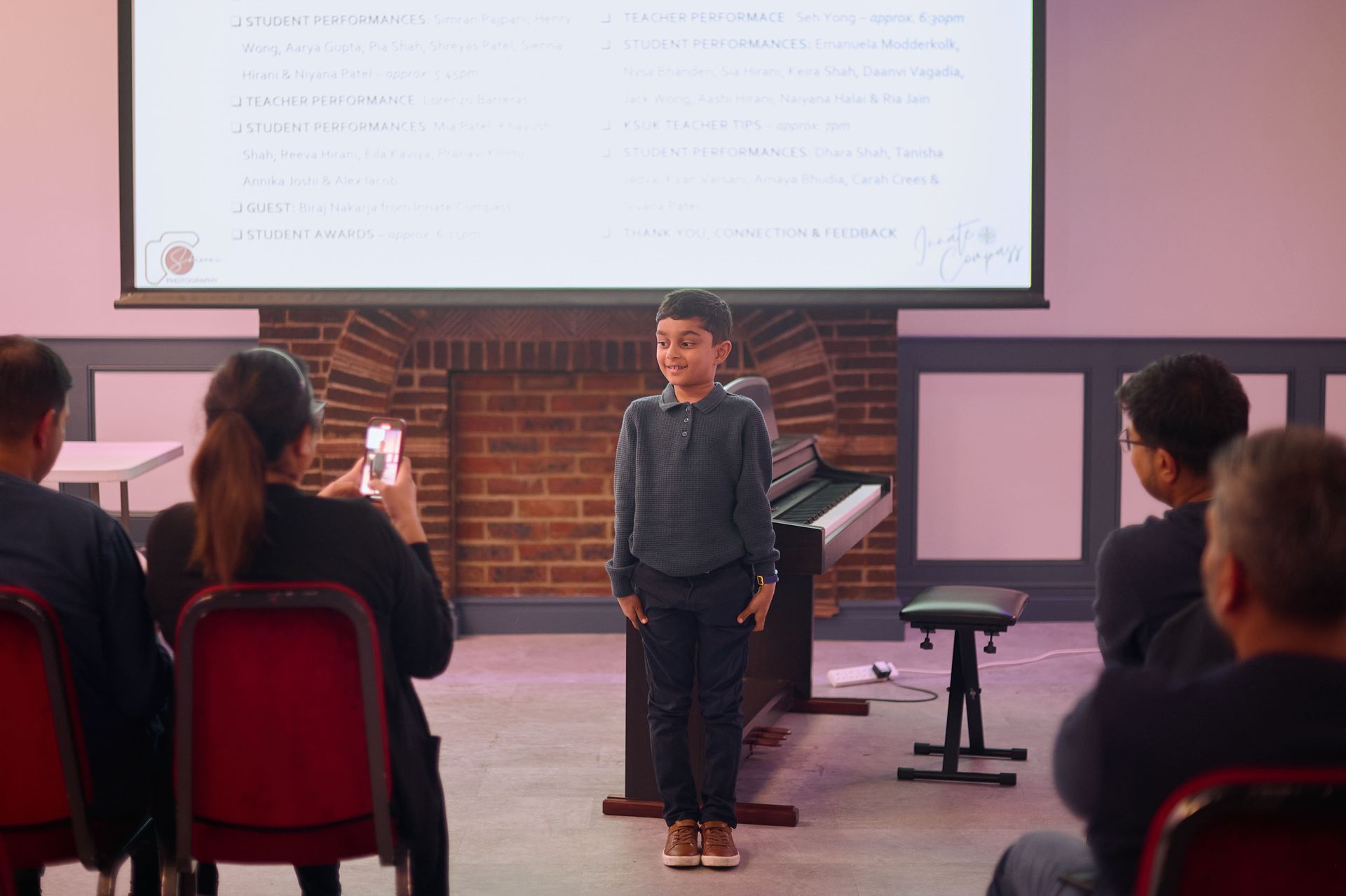
Piano is one of the most powerful tools for building skills that transfer directly into school performance, concentration, problem-solving, and confidence. Here’s how piano lessons genuinely support academic success. Piano strengthens focus, memory and brain development. Learning the piano engages multiple parts of the brain at once - listening, reading, motor skills, creativity, and problem-solving. This strengthens “executive function,” which directly impacts a child’s ability to learn. Academic connections: ● Stronger working memory → better maths and mental recall ● Better hand–eye coordination → smoother writing and reading ● Improved concentration → longer attention span in school Tip One Try a “focus warm-up” before homework: Ask your child to play one short piece or one scale before they start schoolwork. This activates the brain and primes them to concentrate. If you’d like suggestions for simple musical warm-ups that help with focus, just ask us - we’re happy to share ideas. Remember Piano builds discipline, resilience and improved problem solving skills. Regular practice teaches children how to stick with something even when it feels challenging - an essential skill for academic growth. Over time, they learn how to: ● Break tasks into steps ● Work through frustration ● Set goals and achieve them ● Take responsibility for their own progress These are the same habits that support 11+ preparation, secondary school transition, and exam confidence. Tip Two Use the “5-minute start” method: If practice ever feels overwhelming, set a timer for just 5 minutes. Most children continue naturally once they’ve begun - it reduces resistance and mirrors effective study strategies used in school. Piano encourages emotional intelligence. Children who play music learn how to express themselves, manage emotions, and think creatively - traits increasingly valued by top schools. Piano helps children develop: ● Confidence in performance situations ● Emotional awareness ● Creative thinking and improvisation ● A sense of identity and personal achievement Piano is a helpful addition in school applications (where appropriate). While no school admits a child because they play piano, many schools value well-rounded students who show commitment, skill development, and personal interests. Music often strengthens school interviews because children can talk confidently about: ● A hobby they’ve committed to ● Performances they’ve done ● Challenges they’ve overcome If you’re unsure how piano is supporting your child’s academic growth or want advice on practice habits, confidence-building, or balancing piano with school please reach out at any time. We’re here to help your child thrive and support where we can!

The Christmas holidays bring a wonderful mix of excitement, travel, downtime, and disrupted routines. That’s why many families find piano practice looks a little different this time of year and that’s completely okay. Here are practical, flexible ideas to help your child enjoy music over the break without stress. 1. Recognise That Holiday Routines Are Different Between visitors, late nights, and festive events, practice may not happen the same way it does during the school term. The aim is simply to keep music present, not perfect. If you’re travelling or unsure how much practice to aim for, please feel free to message us we can offer personalised suggestions. 2. Set Realistic, Flexible Goals Instead of a strict schedule, try giving the break a gentle musical focus. Examples families often use: ● A few shorter practice moments throughout the week ● Focusing on one special piece over the holiday ● Following the full practice plan from their teacher, if appropriate ● Simply maintaining familiarity with current pieces There’s no single “right” amount do what works for your family and follow your teacher’s guidance. 3. Make Piano Festive and Fun The holidays are the perfect time to turn music into a joyful part of your celebrations. Fun ideas: ● Learn a festive piece together ● Play duets with siblings or grandparents ● Record a short video to send to relatives ● Create a “musical advent calendar” with tiny daily challenges ● Hold a cosy at-home Christmas mini-recital If you'd like suggestions for holiday-appropriate pieces at your child’s level, just ask us. We love helping with this! 4. Practice Options for Busy Days or Travel If you’re away from the piano, there are still ways to keep musical skills fresh. Try these: ● Rhythm clapping games ● Listening to pieces they’re learning ● Mental practice for older students ● App-based note-reading or rhythm games ● Bringing a small keyboard if it's convenient Let us know your holiday plans and we can tailor some light-touch ideas for your child. 5. Returning to Routine in January Jumping straight back into full practice might feel tough and that’s normal. Support a smooth transition by: ● Starting with shorter sessions ● Revisiting pieces learned before the break ● Setting a fresh, exciting goal for the new term ● Talking about what they enjoyed musically over the holidays At the first lesson back, we’ll happily help rebuild momentum and create a refreshed practice plan. Final Reminder: We’re Here for You Christmas should feel joyful, not pressured. If you’re ever unsure about how to handle practice, what repertoire to choose, or how to keep things fun, you’re welcome to reach out to us at any point. We love supporting your child’s musical journey - in lessons, between lessons, and throughout every season of the year.

